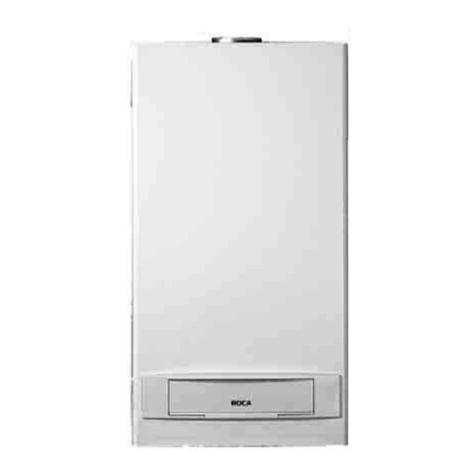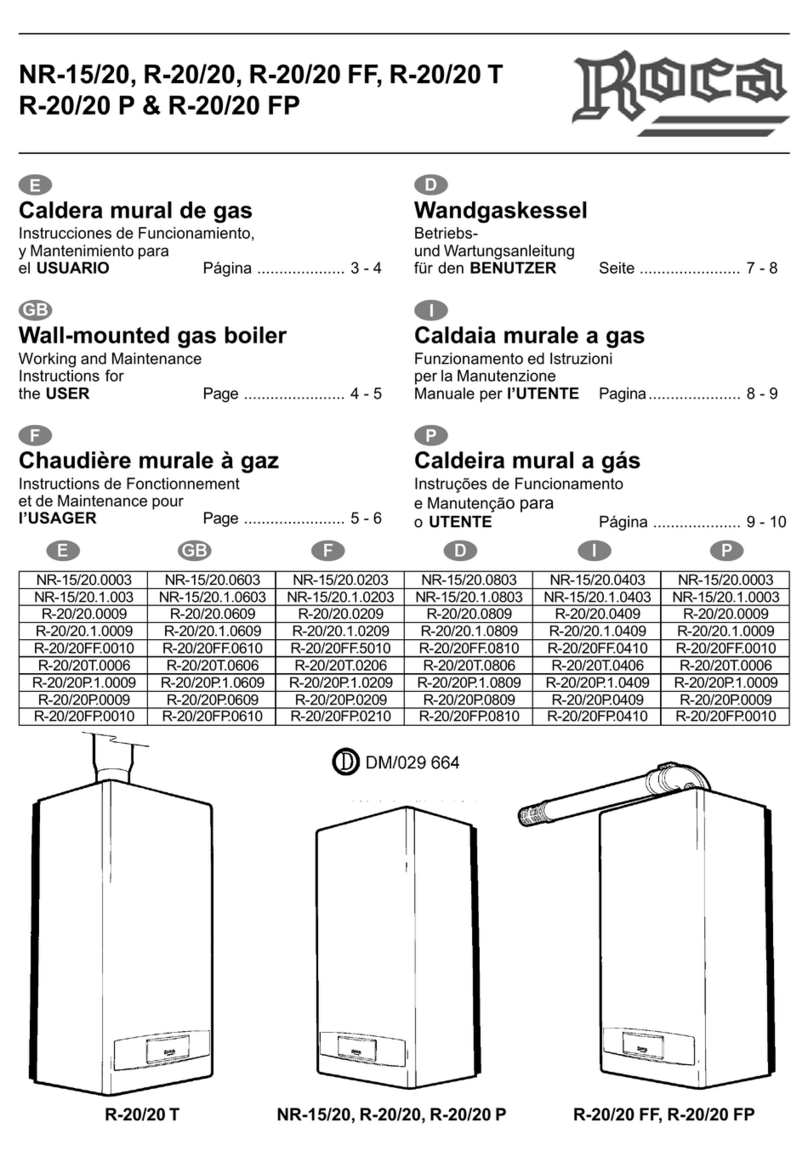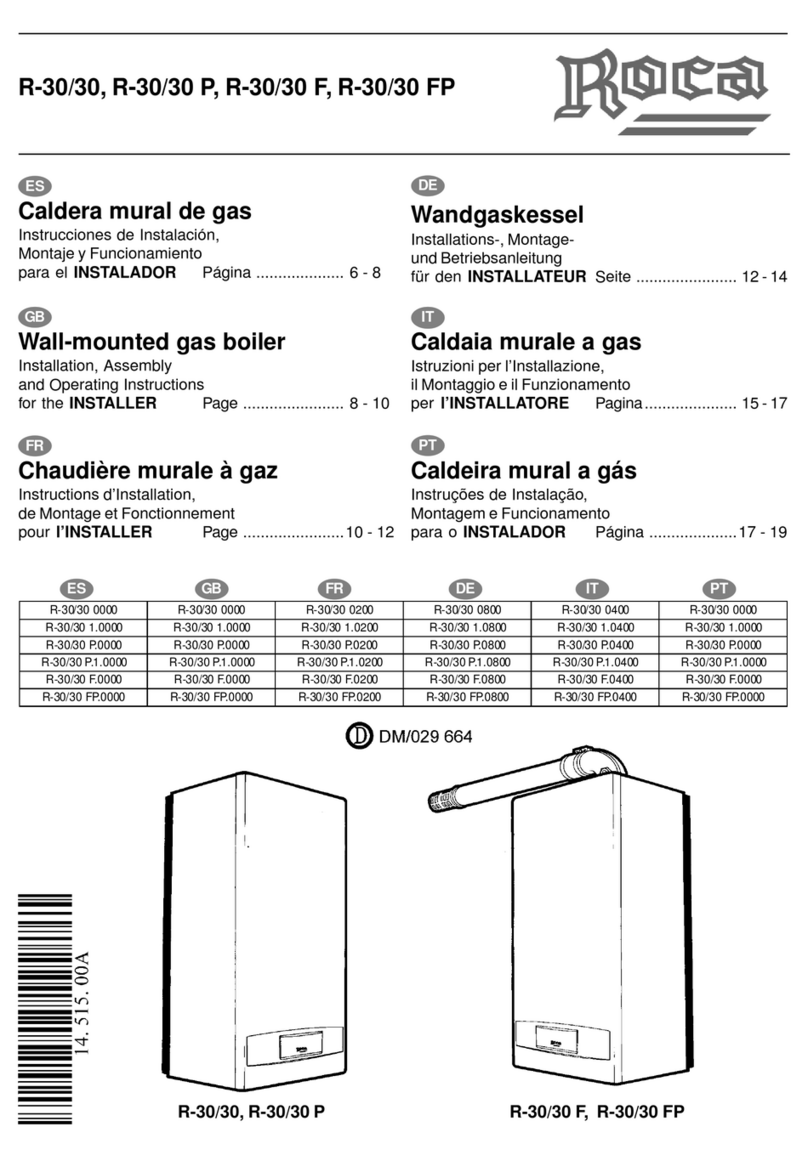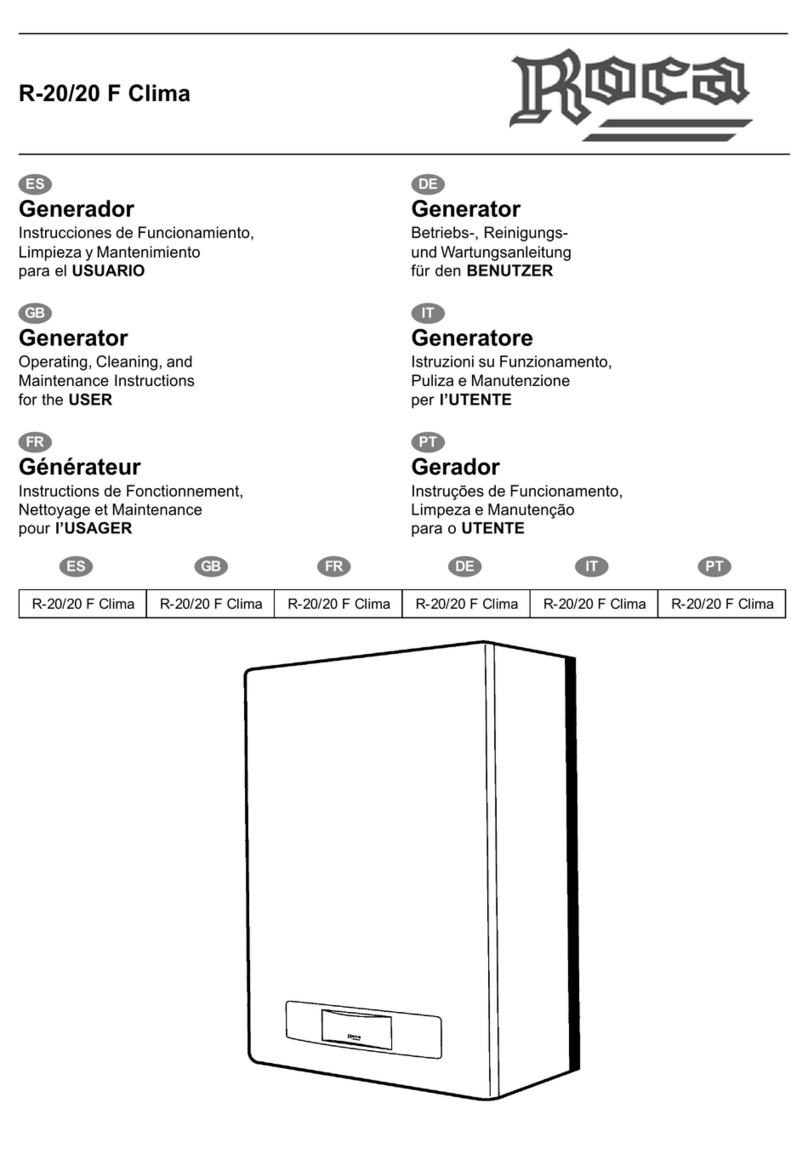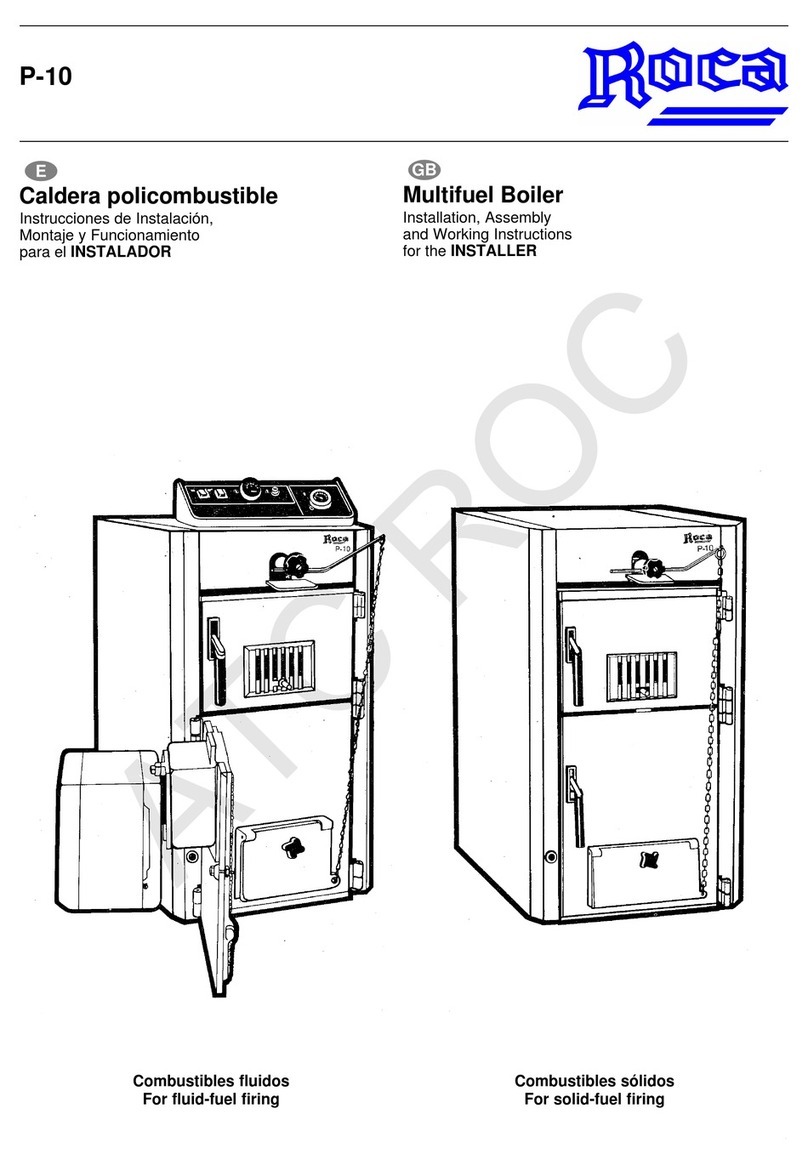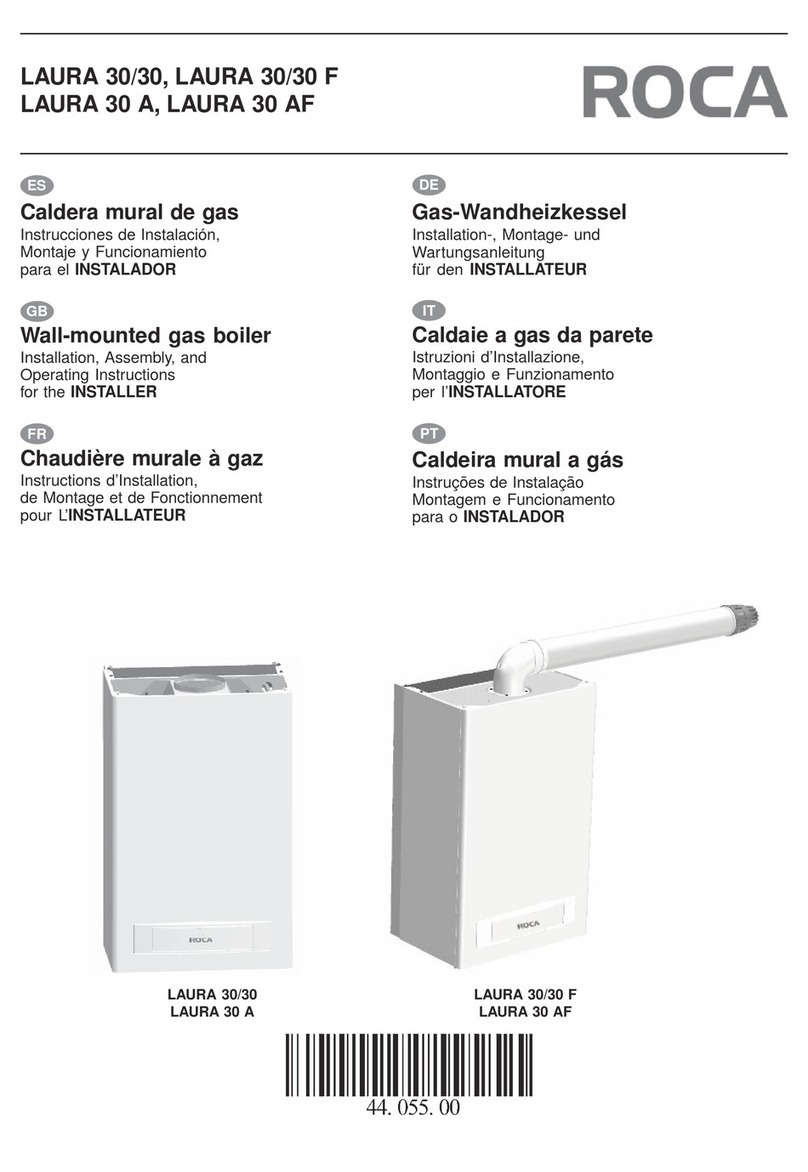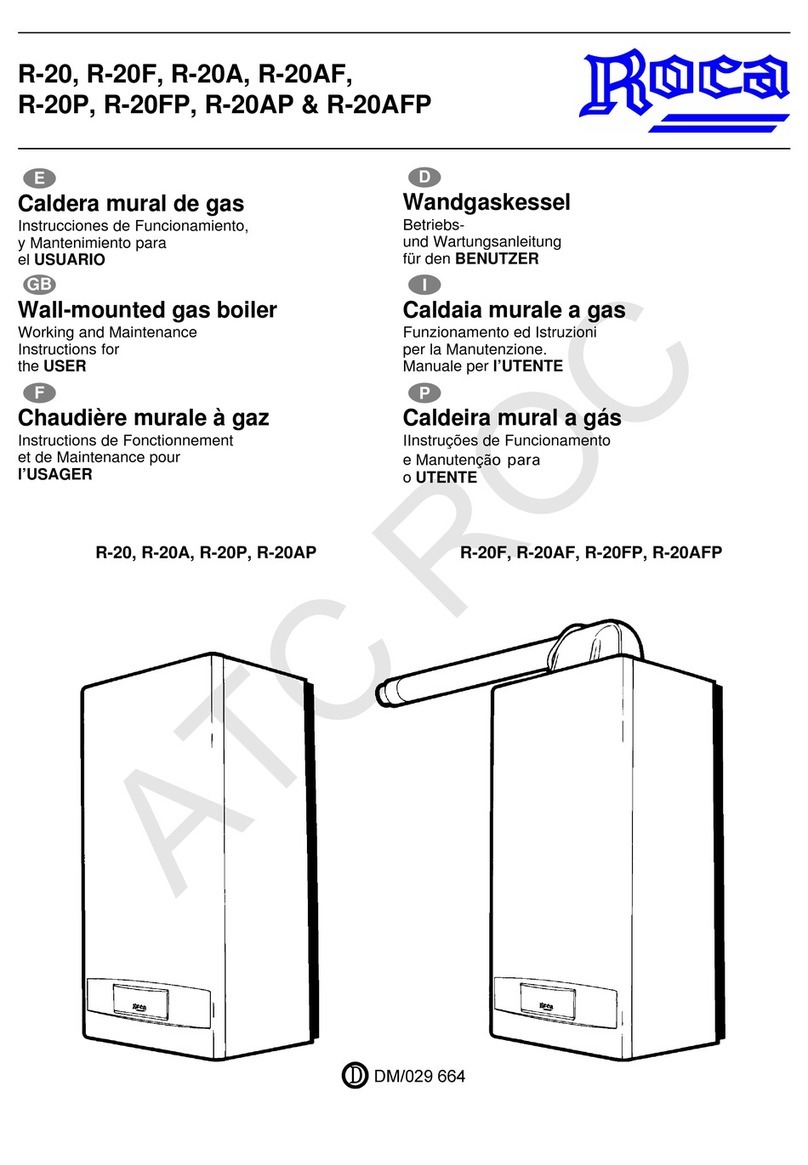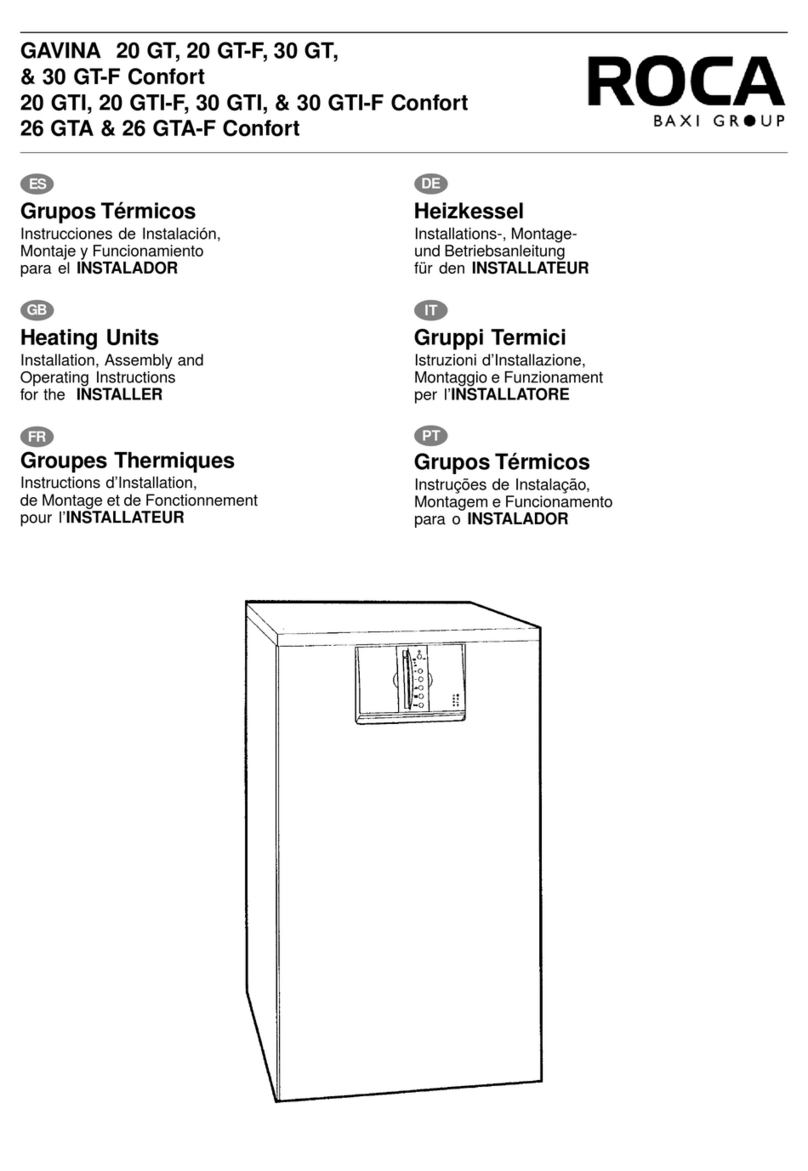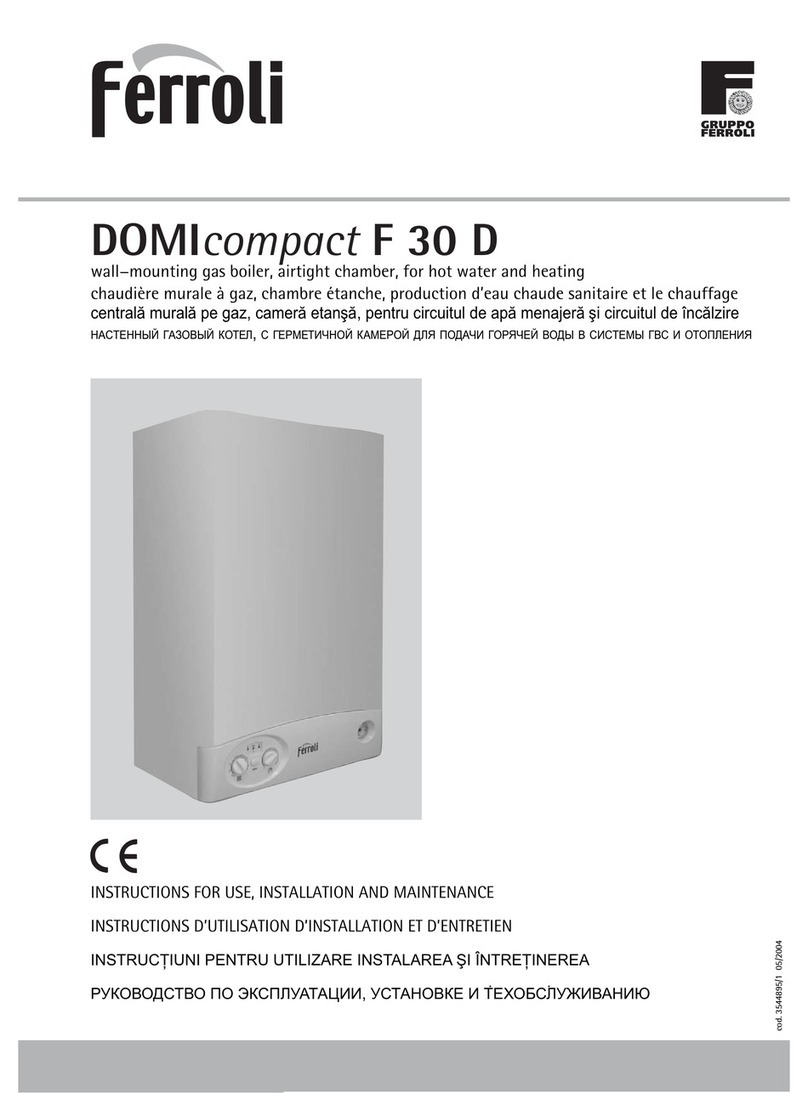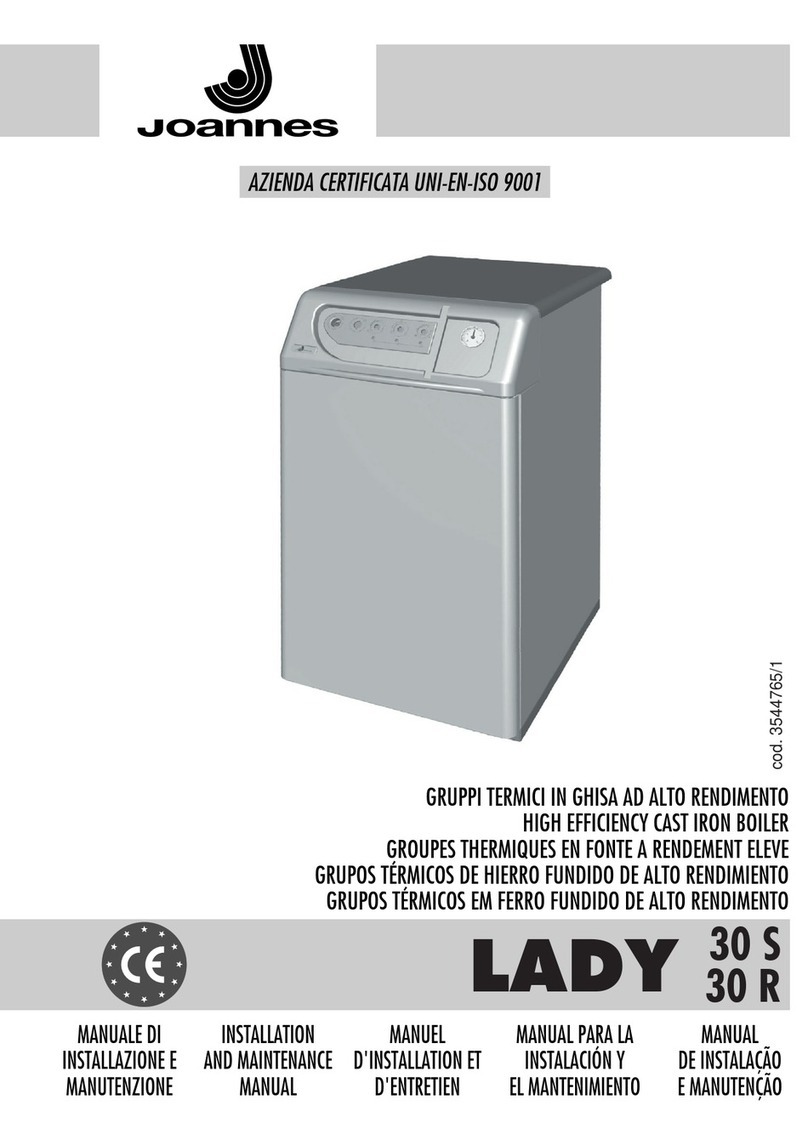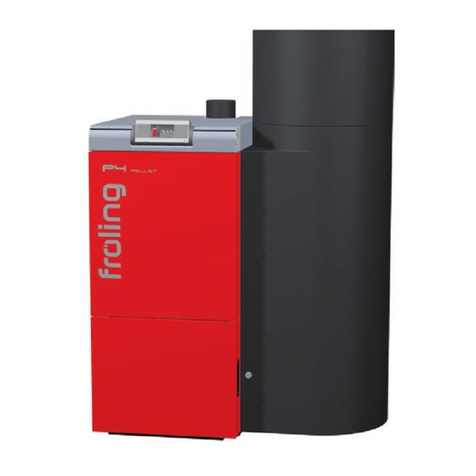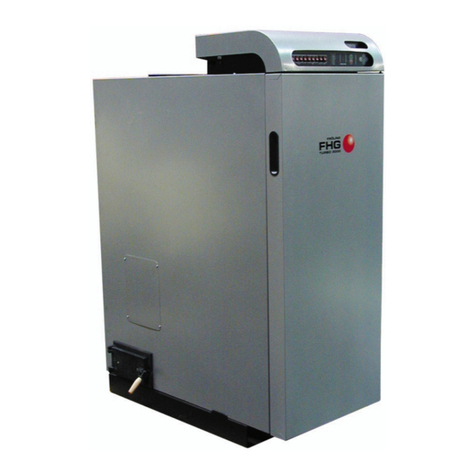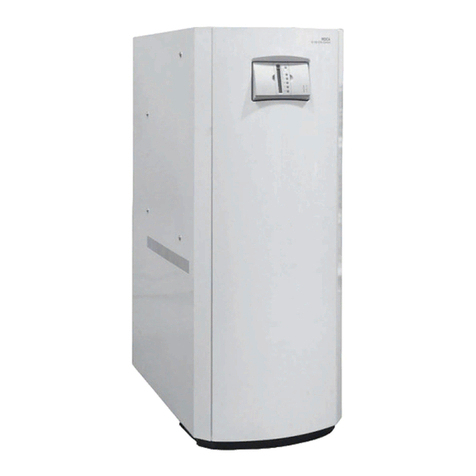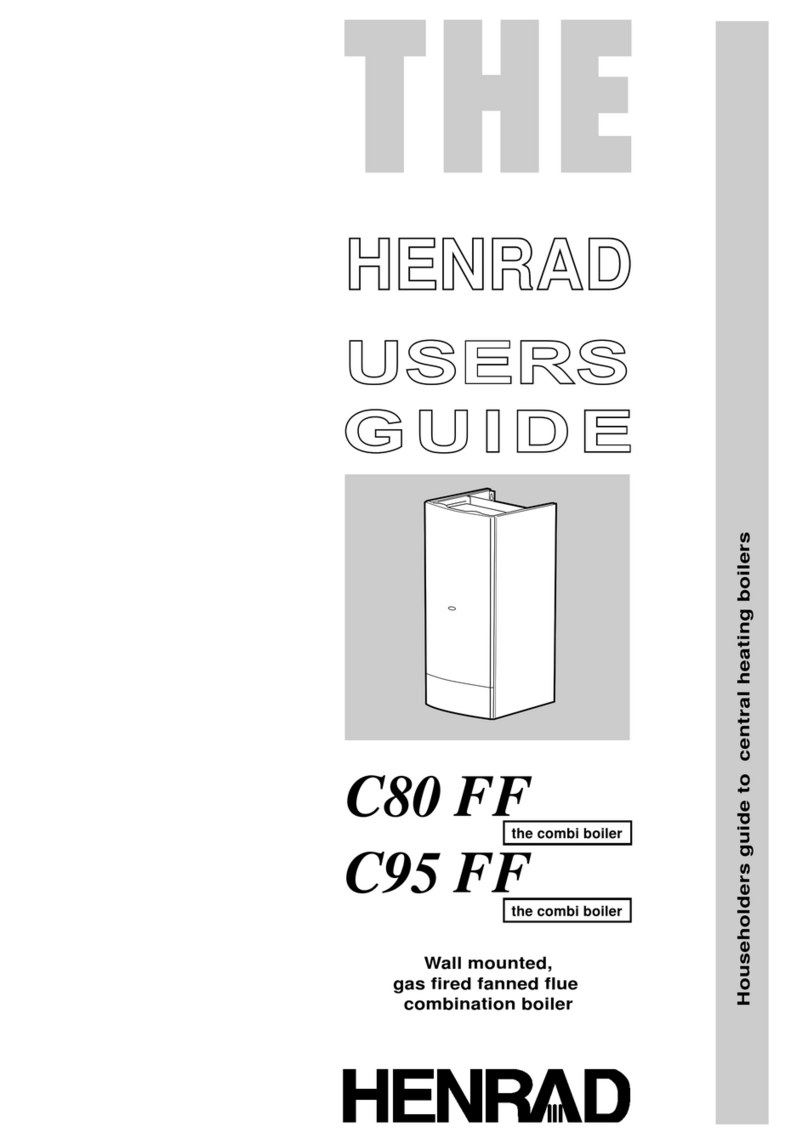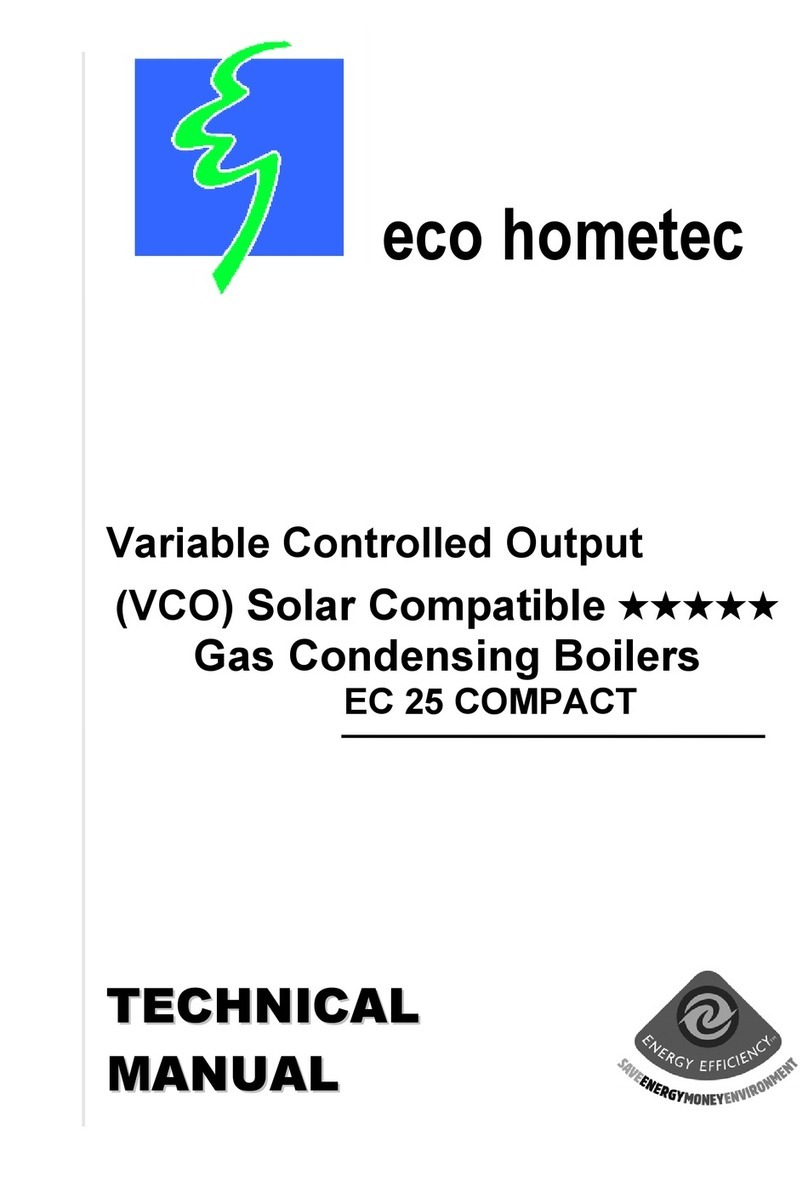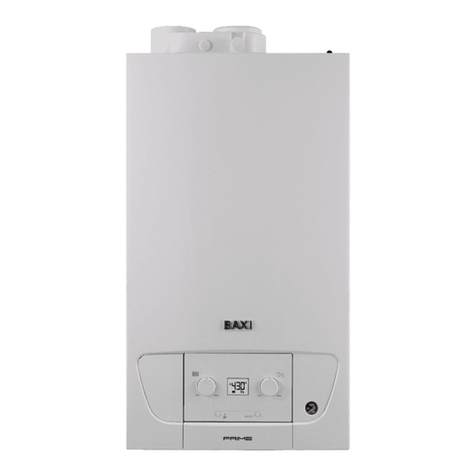
3
Main characteristics
BoilerwithHeatingandinstant.HotWaterservice.
Heating service
Power output: from 6,000 kcal/h (7 kW) to 20,000
kcal/h (23.25 kW).
Adjustablefrom 10,000 kcal/h (11.6 kW) to 15,000
kcal/h (17.44 kW).
Maximum pressure of the circuit: 3 bar.
Maximum temperature: 90°C.
Filling pressure: 1.5 bar.
Domestic Hot Water Service (DHW)
Power output: From 6,000 kcal/h (7 kW) to 20,000
kcal/h (23.25 kW).
Maximum pressure of the circuit: 7 bar
Maximum temperature: 60°C
DHW Production: ∆t = 25°C, 13.3 I/min.
∆t = 30°C, 11.2 I/min
∆t = 35°C, 9.5 I/min.
Minimum pressure and flow rate for ignition: 0.2
bar and 3 I/min.
(1 kW = 860 kcal/h)
Regulation and control panel
See Figure 1.
Potentiometers and Buttons
1.Service selection dial: off-summer-winter.
2.Heating circuit temperature selector.
3.DHW temperature selector.
4.Button for gas supply to pilot flame.
5.Piezoelectric.
Indicator lamps
6.Pressure in heating circuit.
7.Temperature in heating circuit.
8.Service demand.
9.Supply voltage.
10.Lock-out.
Identification of the valves
See Figure 2.
11.Safety valve.
12.Heating flow.
13.DHW outlet.
14.Gas inlet.
15.Cold mains water inlet.
16.Heating return.
17.Heating circuit filling valve.
18.Heating circuit drain cock.
Start-up
Check that the electrical socket is in the correct
position,pushingitfirmlyinwards.Ifforanyreason
you need to leave the boiler without electrical
supply, it must be unplugged from the socket. See
Figure 3.
Open the front cover for access to the regulation
and control panel. The green pilot lamp should be
on.Checkthepressureintheheatingcircuit,which
should be at 1.5 bar. See Figure 4.
If the green pilot lamp does not light up, there is
no electricity reaching the unit. Check to see if
any of the safety devices at your mains entry is
disconnected.
Ifthe”0bar”pressurepilotlamplightsup,itmeans
thatthere is a lack ofpressurein the heating circuit.
See Figure 5.
Check that the flow and return heating valves are
in the correct position; both should be fully open.
See Figure 6.
In order to increase the pressure in the circuit, turn
the handle of the filler cock anticlockwise until the
pressure reaches 1.5 bar. See Figure 7. Once the
correct pressure has been reached, close the
flywheel. The red ”0 bar” pilot lamp will go out.
Check that the circulator is turning. Using a
screwdriver,pressthe groove on the shaft to make
it turn.
Check that the cock for gas supply to the boiler is
open. See Figure 2.
Ignition
With the service dial (1) at ”off” (see Fig. 1),
press the gas supply button (4) right back. Without
releasing it, press the ignition button (5). Once the
pilot flame has ignited, wait about 20 seconds
before releasing the supply button (4). Then turn
the service dial (1) to the position required: Winter
or Summer .
Service selection
Winter: Heating and Domestic Hot Water
Checkthat cocks (12),(15),(16) and (19) areopen.
See Figure 2.
Turnthe service selectiondial(1) to (see Fig. 8)
The boiler is now programmed to provide a
service of Heating and Domestic Hot Water, with
preference for the latter.
If the orange pilot lamp lights up, it means that the
boiler is on demand in one of the services.
Heating
Turn the heating selector (2) to the temperature
required (see Fig. 8). If there is a heating demand,
the boiler will start up.
Theboiler will not start up iftheambient thermostat
(optional) is not in the demand position. The
temperature will increase until the maximum
temperature selected is reached.
Domestic Hot Water
Turn the DHW dial (3) to the temperature required
(See Fig. 9). If there is a hot water demand at any
tap, the boiler will start up.
The temperature will increase until the maximum
temperature selected is reached.
Summer: Domestic Hot Water
Check that the cock (15) is open. During this
period,itisrecommendedthatcocks(12)and(16)
be closed. See Figure 2. Turn the dial (1) to the
position (See Fig. 10). The boiler is now
programmed to provide only Domestic Hot Water.
TurntheDHWdial(3) to the temperature required.
Ifthereisahotwaterdemandatanytap,theboiler
will start up.
The temperature will increase until the maximum
temperature selected is reached.
Stop
The service programmed may be cancelled by
turningthe dial (1)to the position. See Figure
11.
At this position, a permanent protection system is
activated to guard against circulator lock-out and
against freezing (see ”Permanent protection”
section).
In order to resume the service, turn the dial (1) as
desired. If you wish to extinguish the pilot flame,
close off the gas cock (14). See Figure 2.
Cleaning
In order to clean the filter at the cold water intake,
proceed as follows (see Figs. 12 and 13): Close
the mains stopcock (19).
Open a hot water tap to release pressure from the
circuit.
Using a size 16-17 spanner or a monkey wrench,
unscrew the cold water intake unit (15) in an
anticlockwise direction. When removing the unit,
the filter will come out. Clean it.
Once it is clean, reassemble the unit by following
the steps described in reverse order.
Finally, to bleed any air that has entered the
system,unscrew the airvent(13) until watercomes
out. Close it again.
Maintenance
Must be performed once a year by specialized
personnel.
Permanent protection
When the dial (1) is left at (See Fig. 11), and
independently of any conventional protection
systems, a permanent protection system will
operate on the circulator and burners, giving the
following services:
Antilock-out
It activates the circulator for 15 seconds every 6
hours.
Anti-inertia
Following every heating service, the circulator
continues to operate for 30 seconds.
Antifreeze
Ifthetemperature of the heating circuit falls to 7°C,
the circulator is activated until it rises to 9°C.
Super antifreeze
If the temperature of the heating circuit falls to 5°C
in extreme conditions, the programme activates
notonlythecirculator,but also the ignition system,
at the minimum output. The burners will go out
after 30 minutes or when the temperature rises to
35°C.
Recomendations
It is recommended that professional services be
hired for the following operations:
Start-up of the boiler
Adjustments.
Verification that the air inlets and ventilation of the
premises where the boiler is installed comply with
regulations.
If the boiler receives no electrical supply, the
permanentprotection system will not be activated.
In this case, the boiler will need to be insulated
and emptied to avoid the risk of freezing. Proceed
as follows:
Close the mains water stopcock (19), and the flow
(12) and return (16) valves of the heating circuit.
See Figure 2.
Open a hot water tap. Open the hot water (13 and
15) and heating (18) drain cocks.
Activate the safety valve (11) by turning it through
90°C.
Smoke evacuation safety
The B11BS boiler is equipped with a device for
controllingtheevacuation of combustion products.
If the boiler observes any disturbance in the
evacuation of the said products, the red lock-out
pilot lamp (10) will light up. See Figure 1.
If the interruption is only momentary, the boiler
will start up again automatically once the recovery
time has elapsed. If, however, the interruption is
permanent, the installer or the nearest After-Sales
service office must be contacted to correct this
fault.
CE Marking
Roca wall-mounted gas boilers conform to
European Directive 89/336/EEC on
Electromagnetic Compatibility and
European Directive 90/396/EEC on Gas
Appliances, European Directive 73/23/ECC
on Low Voltage, and European Directive 92/
42/CEE on Performance.
GB
